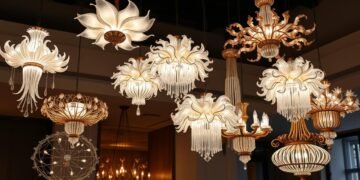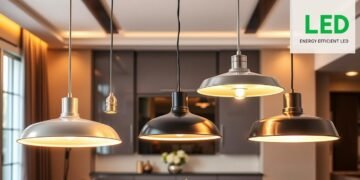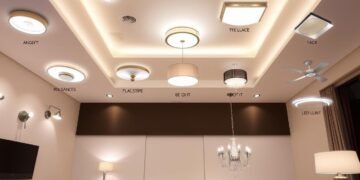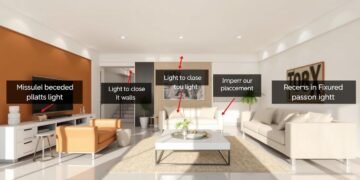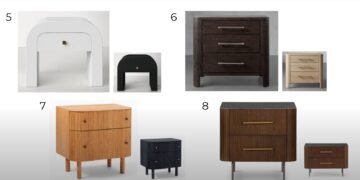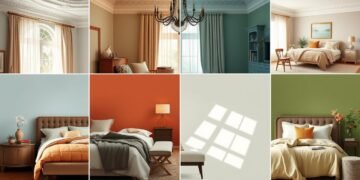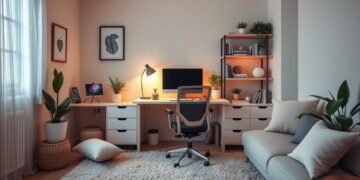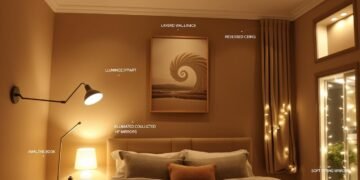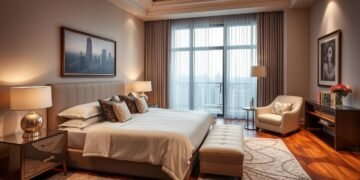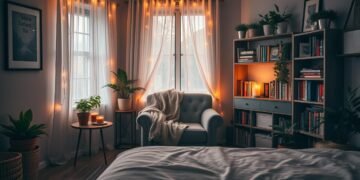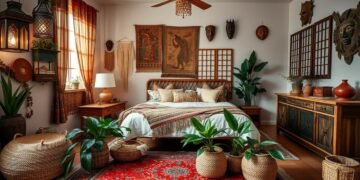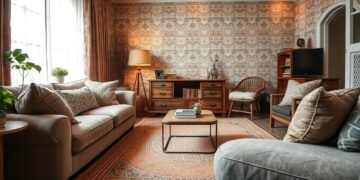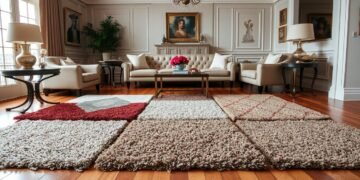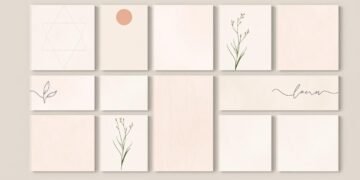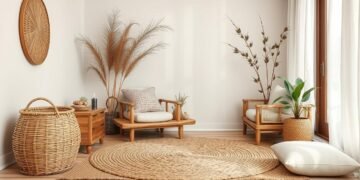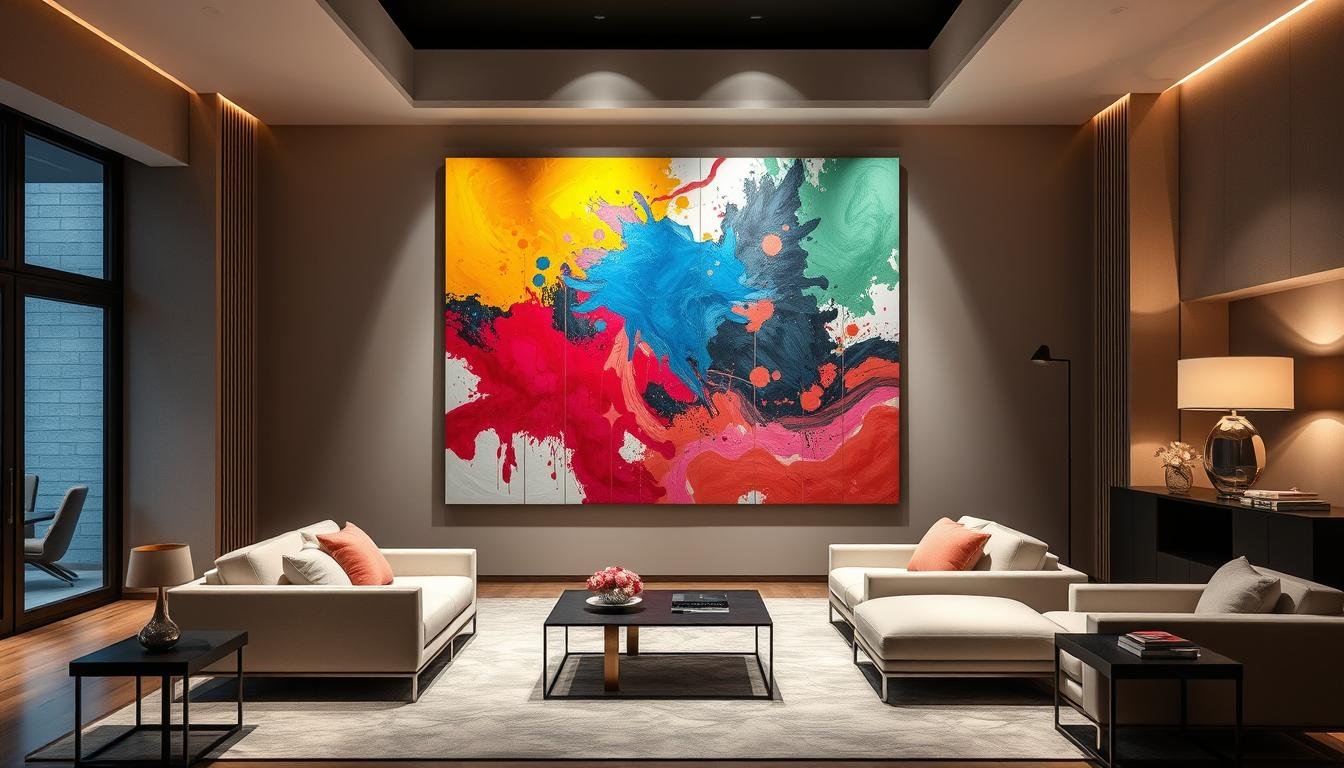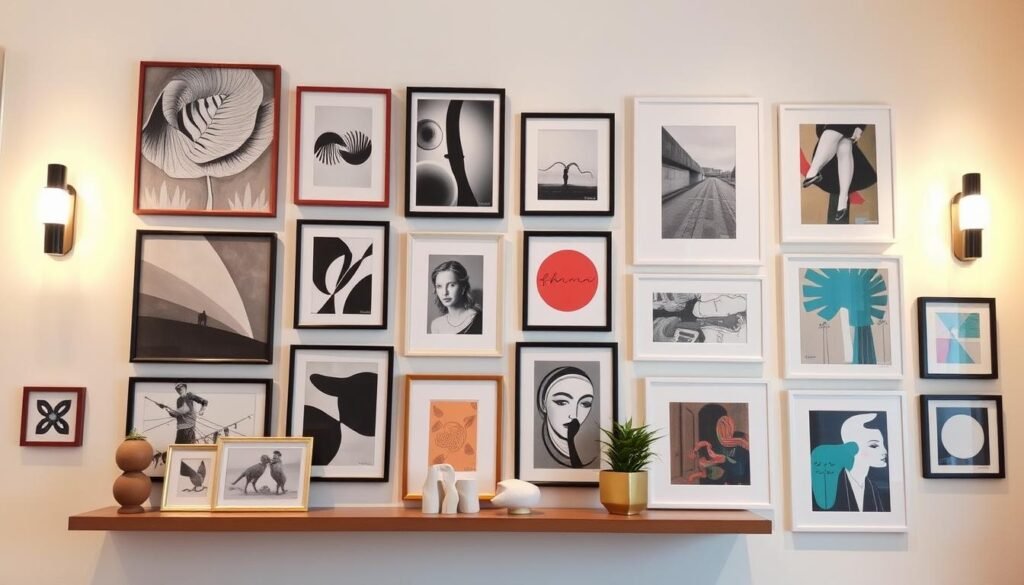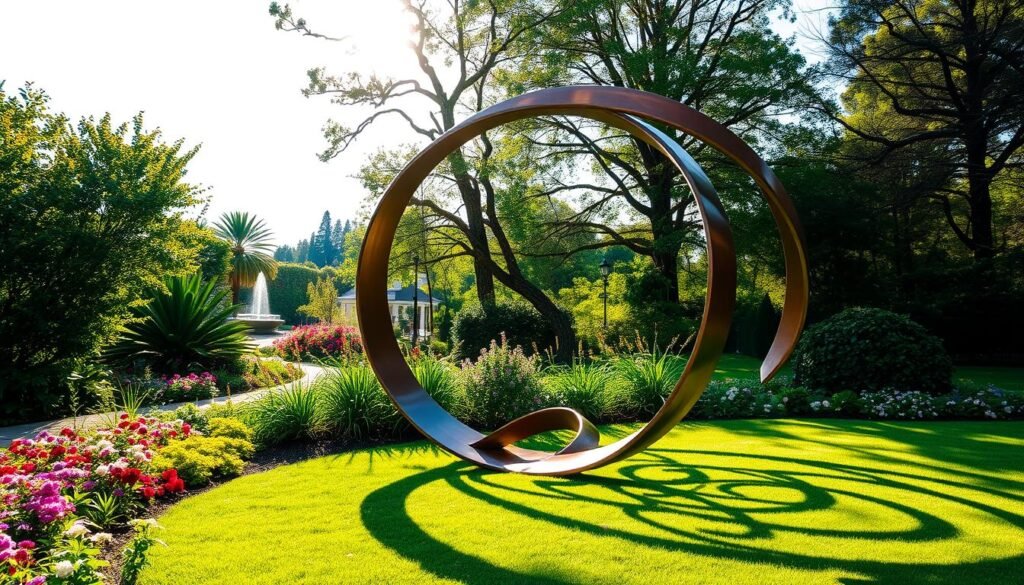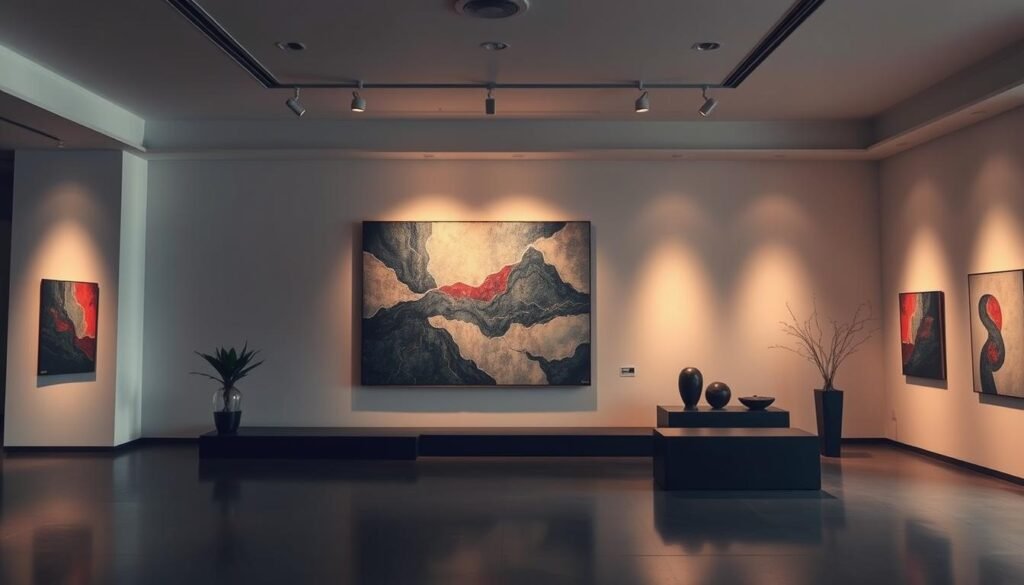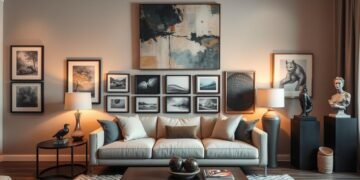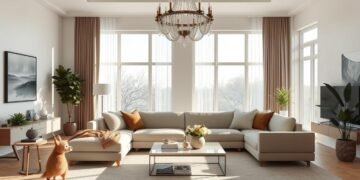When you enter your living room, your eyes go straight to a big abstract painting. It grabs your attention with its bright colors and detailed brushstrokes. This painting turns the room into a stunning focal point.
Whether you love art or just want to make your home look better, knowing how to create a focal point is key. The right artwork, like a bold sculpture or a beautiful landscape, can make a room stand out. It catches your eye and sparks your imagination.
Table of Contents
- 1 Understanding the Power of Statement Art in Interior Design
- 1.1 What Makes Art a Focal Point
- 1.2 The Psychology of Visual Interest
- 1.3 Relatedarticles
- 1.4 8 Approaches to Choosing the Perfect Focal Point for Any Room
- 1.5 7 Rules for Placing Artwork at the Right Height and Scale
- 1.6 5 Common Scale Mistakes and How to Correct Them
- 1.7 Benefits of Using Art as a Centerpiece
- 2 Creating a Focal Point with Art: Essential Principles
- 3 Large-Scale Abstract Art for Dramatic Impact
- 4 Gallery Walls as Statement Pieces
- 5 Using Natural Elements and Landscapes in Focal Art
- 6 Sculptural Art and Three-Dimensional Focal Points
- 7 Color Contrast and Visual Balance in Art Placement
- 8 Lighting Techniques to Enhance Art Focal Points
- 9 Modern Minimalist Approaches to Statement Art
- 10 Conclusion
- 11 FAQ
- 11.1 What makes art a focal point in interior design?
- 11.2 How can statement art serve as a communication tool between the artist and audience?
- 11.3 What are the essential principles for creating a focal point with art?
- 11.4 How can large-scale abstract art transform a space?
- 11.5 What are the benefits of using a gallery wall as a focal point?
- 11.6 How can natural elements and landscapes in art create a focal point?
- 11.7 What role do sculptural art and three-dimensional pieces play in creating focal points?
- 11.8 How can color contrast and visual balance enhance art as a focal point?
- 11.9 What lighting techniques can be used to enhance art focal points?
- 11.10 How can a modern minimalist approach to statement art create a focal point?
- 12 Source Links
Key Takeaways
- Statement art can transform an understated area into an eye-catching interior vignette.
- Large wall art can dramatically change a space, specially in living rooms with ample wall space.
- Gallery walls and natural landscapes are effective in creating visual interest and balance in a room.
- Artwork placement, scale, and color selection are key in setting a focal point.
- Incorporating artistic furniture can elevate the overall look of a space and serve as functional art.
Understanding the Power of Statement Art in Interior Design
Statement art can change a room’s look. It’s more than just decoration. Art composition and framing artwork can make a room stand out. They grab attention and connect the viewer with the art.
What Makes Art a Focal Point
Art can be a room’s main attraction. It pulls the eye and adds interest. Art placement is key. The size and where it’s placed can make or break its impact.
The Psychology of Visual Interest
People are drawn to striking visuals. Statement art uses this to its advantage. It can make us feel, think, and connect with the design.
Benefits of Using Art as a Centerpiece
Using art as a centerpiece in interior design with art has many perks. It makes a accent wall that’s eye-catching. It also shows off your style and ties the room together.
“The right artwork can transform a space, elevating the overall aesthetic and creating a sense of wonder and awe.”
Creating a Focal Point with Art: Essential Principles
Interior design benefits greatly from the right placement of art. This can turn a simple room into a stunning focal point. Consider the size, color, and lighting of your art to achieve this.
The size of your art is key. Big pieces grab your attention and are perfect for blank walls or above fireplaces. Choose colors that match the room’s palette for a balanced look.
Where you place your art matters a lot. Putting it in the center or near architectural features makes it stand out. This creates a sense of purpose and flow in the room.
Lighting is also vital. Use track lights or wall sconces to highlight your art’s texture and colors. This makes your art the main attraction in the room.
By applying these art arrangement principles, you can make any space beautiful. Use art wall decor, composition techniques, color theory, and lighting effects to highlight a statement piece.
“The focal point in design is the area or element that captures the viewer’s attention first.”
| Principle | Description |
|---|---|
| Size | Large-scale artworks have a commanding presence that immediately draw the eye, making them ideal for focal points. |
| Color | The color selection of your art should harmonize with the overall palette of the room, enriching visual cohesion. |
| Placement | Centering a piece above a fireplace or on a blank wall ensures it becomes the primary focus of the space. |
| Lighting | Carefully positioned lighting can dramatically highlight the texture, depth, and colors of your statement piece. |
Large-Scale Abstract Art for Dramatic Impact
Make your space stand out with large-scale abstract art. These pieces can change a room, becoming a focal point that grabs everyone’s attention. When picking oversized abstract art, think about size, color, and where to place it for the best effect.
Choosing the Right Size for Your Space
Choosing the right size is key for abstract art to make a statement. Measure your walls well and use a Wall Art Size Calculator for the perfect fit. Sizes like 61″ x 41″ to 60″ x 48″ are great, fitting well without feeling too big.
Color Selection and Room Harmony
The art’s color should match or contrast with your room’s decor for a striking look. Bright colors can energize a room, while soft tones can calm it. Think about how the art’s color will work with your room’s colors for a balanced look.
Placement Techniques for Maximum Effect
Where you put your art is important for the best effect. Place it in the center of a big wall or use it to frame a furniture group. In places like entryways or living rooms, it becomes a stunning centerpiece. In offices, it can boost creativity and productivity.
Large abstract art can transform your space, making it a focal point that shows off your style. With the right size, color, and spot, these pieces can turn any room into a masterpiece.
“Large abstract canvas paintings offer versatility with a variety of textures, colors, and styles to suit different tastes and preferences.”
Gallery Walls as Statement Pieces
Looking for a way to make your space pop? A gallery wall is perfect. It lets you mix different art styles, sizes, and frames. This creates a stunning display. Choose a theme or color scheme to keep it all together.
Try mixing framed and unframed art for texture. The Lean method is easy and changes often. The Grid layout is symmetrical but needs exact measurements.
For something modern, try the Top-Down style. It starts with a straight line at the top. Or, use the Focal Point method to highlight a big piece with smaller ones around it.
| Gallery Wall Styles | Key Features |
|---|---|
| Lean | Hardware-free, easy to change art |
| Grid | Symmetrical, requires precise measurements |
| Top-Down | Classic gallery with contemporary twist |
| Focal Point | Oversized piece flanked by smaller works |
Gallery walls can also have a Throwback look. Use rope-wrapped wire to hang art and add drama. The Mix style lets you hang different items like wall plates and sconces with art.
For a unified look, use the Match concept. Hang art in the same frames. Or, choose the Common Theme idea for an eclectic look. This shows your style preference.
The secret to a great gallery wall is balance. Mix styles, frames, and layouts to make a statement. Your walls will become a personal showcase, adding interest to any room.
Using Natural Elements and Landscapes in Focal Art
Why not use the beauty of nature in your interior design? Landscape art and nature-inspired decor can make any space feel calm and lively. These elements not only catch the eye but also make rooms feel bigger and more open.
Seascapes and Horizon Compositions
Seascape paintings and dramatic horizons can make a room feel special. They bring a sense of calm and wonder. Choose a piece that matches the mood you want to create, whether it’s a big landscape or a cozy coastal scene.
Nature-Inspired Color Palettes
Bring the outdoors in with color palettes inspired by nature. Soft tones can be calming, while bright colors can add energy. Try different shades to find the right mix that adds depth to your space.
Creating Depth with Natural Scenes
Big landscape art pieces can make a room feel deeper and wider. Use elements like horizons, paths, or foliage to create a sense of distance. This trick can make a room feel more spacious. Place your focal point carefully to enhance this effect.
Sculptural Art and Three-Dimensional Focal Points
Sculptural art and three-dimensional pieces can be powerful focal points in any interior design. These captivating works of 3D art have the ability to transform a space. They add depth, visual interest, and a unique sense of presence. Whether wall-mounted or freestanding, sculptural art can serve both aesthetic and functional purposes. They elevate the overall design and create a true statement piece.
Sculptures, from intricately carved wood to bold metal forms, offer an immersive experience. They draw the eye and spark curiosity. Their three-dimensional impact creates a captivating focal point. It invites guests to explore the piece from multiple angles and appreciate its texture, rhythm, and perspective.
Strategically placing a sculptural focal point can also reinforce a property’s brand identity. It creates a unique selling point and resonates with target demographics. Practical considerations, such as durability, maintenance requirements, and budget, should be carefully evaluated. This ensures the sculpture seamlessly integrates into the overall design.
When it comes to sculpture as a focal point, the possibilities are endless. Whether you opt for a modern abstract piece or a classical figure, the transformative power of three-dimensional art can elevate any interior space. It captivates the senses and leaves a lasting impression.
“Sculpture is the art of the intelligence; painting is the art of the eye; and architecture is the art of the hand.” – Louis Sullivan
Color Contrast and Visual Balance in Art Placement
Strategically placing art can transform your interior design. Understanding color contrast in art and visual balance in decor helps. This way, you can highlight your statement pieces and blend them with your space.
Working with Neutral Backgrounds
Neutral walls and furniture are ideal for bold color art. A neutral art color palette lets your artwork shine. Choose a piece with a high-contrast color to grab attention.
Bold Color Combinations
Pairing art with bold color combinations in decor creates a dynamic focal point. When the art color palette matches or contrasts with the room, it adds energy. Try complementary colors or unexpected pairings for a striking look.
Creating Harmony with Existing Decor
To blend art with decor, pick artwork that matches your room’s colors. This color contrast in art creates a cohesive look. Your art becomes the focal point without feeling out of place.
The secret to great art placement is finding balance. Consider color, contrast, and harmony. This way, you’ll create a focal point that enhances your space.
Lighting Techniques to Enhance Art Focal Points
Proper lighting for art display is key to making your art stand out. It helps draw the viewer’s eye to the main part of the piece. This way, your artwork looks its best.
Start by using directed spotlights or track lighting to focus on certain artworks. For paintings, aim the light at a 30-degree angle from the center. This reduces glare and spreads the light evenly. You can adjust the lighting to change the mood of your space.
While natural light is great, direct sunlight can harm some artworks. Use windows carefully to add beauty without damaging your art. Make sure to watch out for UV rays and adjust as needed.
- Use directed spotlights or track lighting to highlight focal art pieces
- Angle lighting at 30 degrees to reduce glare on paintings
- Experiment with adjustable lighting to create the desired mood and ambiance
- Incorporate natural light strategically, but protect art from UV damage
- Combine ambient and accent lighting to enhance the overall viewing experience
By carefully choosing lighting techniques, you can make your space more interesting. Try different methods to find the best way to show off your art.
“Lighting has a major impact on the ambiance of art galleries and museums. Proper lighting solutions can create an inviting atmosphere while bringing out all the details in the artwork on display.”
| Lighting Type | Benefits | Considerations |
|---|---|---|
| Incandescent Bulbs | Warm, natural appearance | Higher energy consumption, shorter lifespan |
| LED Lights | Energy-efficient, adjustable color temperature | Higher initial cost, possible glare |
| Halogen Bulbs | Bright, crisp illumination | Generates heat, fire hazard risk |
| Fluorescent Lamps | Efficient, uniform lighting | Limited color rendering, possible flicker |
Modern Minimalist Approaches to Statement Art
In interior design, modern minimalist art is a big hit. It uses simplicity and restraint to make a big impact. Artists like Yayoi Kusama and Gerhard Richter create art that is simple yet powerful.
Geometric Patterns and Forms
Geometric patterns and forms add a bold touch to minimalist spaces. For example, the Hoven Table Lamp by Disc Interiors has a clean, geometric shape. It fits perfectly with a minimalist look, drawing the eye without being too much.
Space and Proportion in Minimalist Art
How the art fits with the space around it is key in minimalist art. Giving the art room to breathe creates a balance that shows off simple compositions. This way, the art stands out without feeling too much.
Using modern minimalist art in your home can change it for the better. It focuses on simple compositions, geometric patterns, and balanced proportions. This creates a space that is both beautiful and calm, following the rules of modern minimalist art.
“Minimalist art allows the viewer to focus on the essence of the piece, stripped of unnecessary details. It’s a powerful way to create a statement and inspire contemplation.”
– Curator, Artfully Walls
Conclusion
Creating a focal point with statement art can change your living space a lot. It adds personality, depth, and visual interest. You can choose big abstracts, a gallery wall, nature scenes, sculptural art, or go simple. The right art can make your room’s design pop and show off your style.
When picking a focal point, think about the art’s size, color, where to put it, and how it’s lit. Good art placement is about finding balance and fitting with your room’s design. This way, you can make your space more interesting and welcoming to everyone.
Using statement art as a centerpiece opens up many ways to make your home special. It lets you add visual interest and show off your creativity. Your living spaces can become places that inspire and bring joy.
FAQ
What makes art a focal point in interior design?
How can statement art serve as a communication tool between the artist and audience?
What are the essential principles for creating a focal point with art?
How can large-scale abstract art transform a space?
What are the benefits of using a gallery wall as a focal point?
How can natural elements and landscapes in art create a focal point?
What role do sculptural art and three-dimensional pieces play in creating focal points?
How can color contrast and visual balance enhance art as a focal point?
What lighting techniques can be used to enhance art focal points?
How can a modern minimalist approach to statement art create a focal point?
Source Links
- 10 Innovative Ways to Add a Focal Point to Your Living Room Without a Fireplace
- 10 Powerful Artist Statement Examples & Expert Tips | Format
- Artistic Expression: Using Artwork as a Focal Point in Design
- Art as a Focal Point: Creating Statement Walls in Interior Design
- Creating a Focal Point: The Art of Statement Pieces in Interior Design – Kern & Co.
- What is Focal Point (Design Principle)?
- Design Principles: Dominance, Focal Points And Hierarchy
- Emphasis – A Principle of Art
- Abstract Paintings for Living Rooms: A Bold Fusion of Art, Emotion, and Design
- Large Abstract Paintings for Sale
- Best Oversized Wall Art Ideas: Large Canvas & Abstract Art for Big Walls
- 8 Artful Takes on the Gallery Wall
- DESIGN MISTAKE: Different Walls, Same Art Configurations (AKA It’s Time To Bring Life To Your Walls) – Emily Henderson
- An Exploration of the Focal Point in a Painting – OutdoorPainter
- How to Create a Beautiful Focal Point Landscape Design for Your Garden – Discovering Your Cosmic Self
- Creating a focal point in textured art – Kore Sage | Mixed Media Artist
- How To Use Focus And Create A Focal Point In Art | Wood Art Studio
- How to Use Sculptures to Create a Focal Point in Your Living Room
- Brigham Young University-Idaho ART 110
- How to Master Focal Points in Image Composition
- 3.4: Principles of Design- Emphasis, Focal Point, and Subordination
- 5 Effective Techniques For Creating A Focal Area In Your Art
- Focal Point in Art | Learn to Paint Watercolor
- The Fine Art of Lighting Art
- Subtle Statements: How to Incorporate Art Prints in Minimalist Decor
- Minimalism Meets Wabi-Sabi: A Guide to Curating Thoughtful Wall Art
- The Artful Home: Exploring the Popularity of Minimalism in Wall Decor
- Understanding how to guide the viewer’s eye
- Focal Point Vs. Center of Interest – Stefan Baumann

